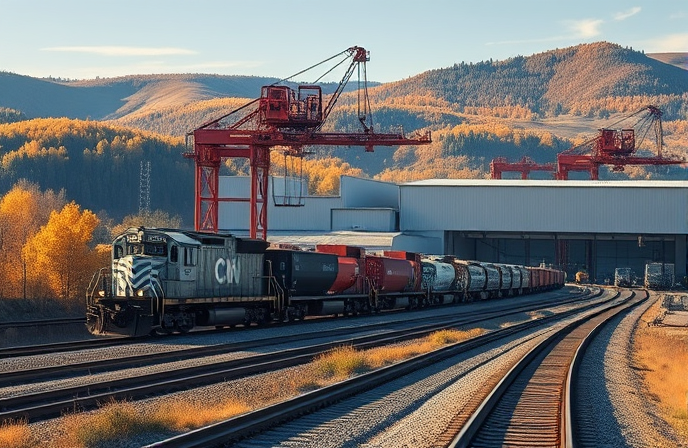CN’s Transload Program: Rail Volume Growth in North America
CN Railway expands transloading network with top partners, boosting railcar volumes and service across North America.

CN Bolsters Transloading Network with Top-Tier Partner Program
Canadian National Railway (CN) is expanding its transloading network, a strategic move aimed at increasing railcar volumes and enhancing service across its extensive North American network. The initiative, announced on cn.ca, involves collaborative efforts with members of CN’s Top-Tier Transload Partner Program. This partnership strategy, encompassing the “who” (CN and third-party transloaders), “what” (expansion of transloading capacity), “when” (ongoing initiative), “where” (across the CN network), “why” (to increase rail use and improve service), and “how” (through strategic partnerships and incentives), is a critical component of CN’s growth strategy. This article explores the program’s structure, benefits, and implications for the broader rail industry.
The Top-Tier Transload Partner Program: A Strategic Overview
The CN Top-Tier Transload Partner Program identifies and recognizes third-party transloaders who meet specific performance criteria and safety standards. To qualify, partners must handle a substantial volume of carloads, specifically 500 or more units annually. Furthermore, these partners must adhere to stringent safety and service standards. CN’s rationale for this program is clear: these top-tier partners play a pivotal role in broadening the use of rail transportation, which offers an environmentally friendly and efficient alternative to other forms of freight transport, especially as environmental regulations become stricter. This model is designed to be mutually beneficial; CN gains expanded capacity and access to new markets, while the partners secure a more robust and reliable service with the support of a major Class I railway.
Partner Benefits: A Win-Win Scenario
The benefits of the Top-Tier Transload Partner Program extend beyond increased carload volume. Participating transloaders gain significant advantages, including heightened visibility within CN’s marketing and customer channels. This can translate to increased business opportunities and brand recognition. Further benefits encompass the right to use the CN Top-Tier badge for promotional purposes, a significant asset in attracting new customers and establishing credibility in the market. Each partner also receives a dedicated CN account manager, ensuring streamlined communication and personalized service. Moreover, top-tier partners become eligible for the Class I’s Top-Tier Partner Awards Program, recognizing outstanding performance and commitment to service excellence. These incentives are crucial in fostering strong partnerships and motivating transloaders to contribute to CN’s growth goals.
A Case Study: CREWS and CN’s Johnstown Collaboration
A compelling example of the success of the Top-Tier Transload Partner Program is the ongoing collaboration between CN and Canadian Rail Equipment Works and Services (CREWS) at CREWS’s Johnstown, Ontario, location. Through joint sales efforts and carefully coordinated business opportunities, CN and CREWS have achieved impressive year-over-year growth in carload volumes at this location. This success demonstrates the effectiveness of CN’s strategic partnership model. It shows that with proactive management and combined resources, a Class I railway and a third-party transloader can achieve significant expansion in carload volumes and service quality. The collaboration serves as a model for other potential partnerships across the CN network, highlighting the program’s potential for scalability.
Industry Implications and Future Outlook
CN’s proactive expansion of its transloading network, facilitated by the Top-Tier Transload Partner Program, has several important implications for the railway industry. First, it signals a concerted effort to capture a larger share of the freight market, particularly in regions where rail transport offers a cost-effective and environmentally responsible solution. Second, the program underscores the importance of collaborative relationships between Class I railways and third-party service providers. By offering incentives and support, CN is actively fostering a more robust and resilient supply chain. The success of this model will likely encourage other railways to explore similar partnership strategies. Looking ahead, the increased transloading capacity provided by the program will allow CN to support growing demand for rail transport and contribute to the efficient movement of goods across North America. This focus on strategic partnerships, combined with a dedication to safety and customer service, positions CN for continued success in a rapidly evolving freight landscape.
Company Summary
Canadian National Railway (CN), a major Class I railway, operates a vast network spanning North America, encompassing approximately 20,000 route miles of track. The railway handles a wide range of commodities, including chemicals, grain, coal, and consumer products. CN is committed to sustainable practices, seeking to optimize fuel efficiency and reduce emissions, and is a critical player in the North American economy, facilitating the transportation of goods across borders and contributing significantly to the efficiency of the continent’s supply chains.




